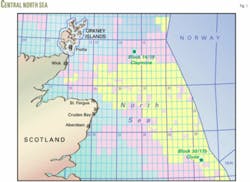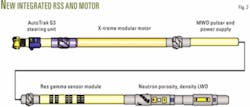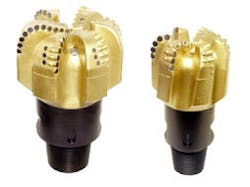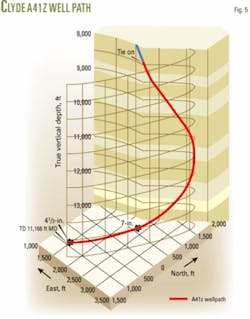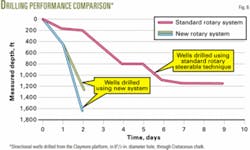Coupling a drilling motor with a high-speed rotary steerable tool and new steerable bits is a successful approach to drilling the Cretaceous section in cost-sensitive, mature North Sea fields.
The Central North Sea (CNS) Cretaceous formations are notoriously difficult for performing directional drilling operations. Oriented drilling using bent-housing steerable motors is troublesome and rate of penetration is unacceptably slow with rotary steerable systems. This has historically resulted in well trajectories being planned with minimal directional course changes through these sequences.
When directional course changes are absolutely necessary, oil-based mud is often required to facilitate drilling. With many assets in the CNS reaching maturity, directional drilling course changes in the Cretaceous have increasingly become necessary to access remaining targets.
Talisman Energy (UK) Ltd. acquired several CNS mature assets during 1997-2005. One of the challenges faced was to improve directional drilling control and overall drilling performance through the CNS Cretaceous while simultaneously moving away from the use of oil-based mud.
One of the possible solutions was using a new generation rotary steerable system that integrates a performance drilling motor with a high-speed rotary steerable tool. With this new system, and the latest steerable drillbit technology, precise three-dimensional trajectories are now drilled more than twice as fast.
This article describes the drilling conditions in the CNS and use of the new drilling technology. It also describes the challenges encountered applying new technology on cost-sensitive mature assets, procedures put in place to minimize operational risk while introducing the new system, and a comparison of performance with that of offset wells.
History
The UK CNS covers an area from Block 14 in the north through Block 31 in the south and is an important area for North Sea hydrocarbon production (Fig. 1). A number of fields discovered there in the 1970s were quickly developed and commenced production in the late 1970s or early 1980s. Many are still producing but are past peak production. A challenge faced by the operators is to maintain economic recovery from these maturing assets.
The primary source of production is from Jurassic sands with some fields producing from the Lower Cretaceous itself. To reach these producing zones, it is necessary to drill through the Cretaceous formations, which are dominated by chalk and marl.
Since the early 1970s, when development drilling first commenced in the CNS, the Cretaceous section has been recognized as a significant drilling challenge, limiting both drilling performance and development drilling options. New wells normally drill through the Cretaceous with 12¼-in.-diameter hole while reentry wells frequently drill with 8½-in. diameter. Typical problems encountered are:
- Unpredictable, widely varying, and normally low rates of penetration (ROP).
- Troublesome oriented drilling with steerable motors or turbines.
- Hole spiraling and ledging.
- High friction factors.
- High levels of drilling vibration.
- Unpredictable but strong natural directional tendency.
These problems have limited well trajectories to either tangent or drop through the Cretaceous section. Only in extreme circumstances are directional course changes planned in these wells because it significantly increases well costs and operational risk. With several hundred development wells in the area, many different directional drilling techniques have been tried by numerous operators to overcome the challenges; however, the problems, risks, and associated limitations remained.
Because many fields in the CNS have reached or are reaching maturity, improving drilling performance and attaining reliable directional control through the Cretaceous were critically important for maintaining the economic viability of these assets. The main goals were to:
- Lower drilling costs.
- Significantly improve and reliably predict drilling performance.
- Gain access to remaining reserves from new wells or reentries requiring complex directional profiles.
Drilling performance
Talisman Energy began aquiring CNS assets in 1997 and is now the principal operator in several CNS blocks and fields. One of the objectives of the drilling team was to further understand the drilling obstacles of the CNS Cretaceous and make recommendations to overcome them.
Some studies had already been made by others,1 2 but no recent reports were publically available. Talisman instigated an up-to-date detailed study, resulting in recommendations for further investigation, including field tests of a new drilling system which was being introduced in the North Sea by a major service company.
New drilling system
This system integrates two established drilling technologies -the AutoTrak rotary closed loop system and X-treme precontoured performance drilling motor technology.
Basically, a specially designed, high powered, precontoured drilling motor is positioned within the bottomhole assembly (BHA) immediately above the steering unit and below the measurement while drilling (MWD) and logging while drilling (LWD) sensor subs. Providing drilling power directly from the integrated modular motor to the drillbit results in various benefits. The AutoTrak X-treme system and its benefits are described elsewhere.3-6
Fig. 2 provides a schematic showing a typical BHA configuration of the new system.
Driving the drillbit on the rotary steerable system with a low speed, high-torque drilling motor, we anticipated that this new system would address the recommendations from the Talisman study and provide an enhanced tool for drilling the CNS Cretaceous which would:
- Increase ROP.
- Allow more predicatable ROP.
- Allow easier directional course changes to enable drilling complex well trajectories toward small targets.
In addition to using this new drlling system, Talisman sought to optimize results by applying specifically designed drillbits, which incorporated the latest polycrystalline diamond compact (PDC) bit technology to aid ROP, durability, and steering performance and minimize adverse downhole vibration.
Drillbit development
The drillbit supplier assigned its design appliction review team process to facilitate a structured and systematic approach to improving drillbit performance in CNS assets.
This application-specific approach was used to provide solutions for both the 12¼-in. and 8½-in. sections with primary design concerns being to deliver higher and more predicatable ROPs and durability in these applications. While the goals to increase ROP and durability are common, it was also recogonized that drillbit design can reduce significantly downhole drilling vibration and its subsequent effect on downhole tool reliability.
A study of the target lithologies and resultant drillability analysis determined that a 6 bladed, 16-mm cutter PDC drillbit (IADC M323) was optimal for both 12¼-in. and 8½-in. applications (Fig. 3). To provide the required improvements in ROP and durability, steerability, and reduced downhole vibration, the designs incorporated the latest multi-layered PDC cutter technology and depth-of-cut control technology (DOCC).
Defining objectives, value
Talisman Energy drills in the CNS from existing drilling and production platforms as well as a number of semisubmersible drilling rigs. For its mature fields to remain economically viable, lower well costs are required to drill complex trajectories to intersect smaller drilling targets to access smaller reserves. Drilling costs higher than this economic threshold would result in the cessation of production drilling on some mature assets.
Daily operating rates are relatively low when drilling from the production platforms compared with the semisubmersibles. With platform drilling, the value of early production and the ability to drill cost-effective wells were the primary objectives. With the higher-cost mobile rigs, saving rig time was a significant factor.
In both situations, the potential value of the new system outweighed the operational risk and higher daily cost of the new technology compared with traditional drilling methods.
Case Study A
The Claymore field is a mature asset in Block 14/19. In August 2005, Talisman began a reentry well from the Claymore platform and used a 6¾-in. version of the new drilling system in the 8½-in. hole.
The trajectory of this well was complex. After exiting from the whipstock, the wellpath included a flat left turn to diverge from the original hole (C39z) followed by a 4°/100 ft drop and turn from 57° inclination and 303° azimuth dropping to 34° inclination on a 172° azimuth.
We then drilled a tangent section followed by a final drop to 15° inclination to avoid a fault, and then drilled a final tangent section to intersect the target in the Piper sands.
Fig. 4 shows the trajectory.
Drilling began in slide mode while traversing the whipstock, eliminating the need to rotate the drilling assembly over the face of the whipstock. Near bit inclination measurements indicated that the milling assembly had diverged from the donor well. Once clear of the whipstock, we began full drillstring rotation. Directional control throughout the complex profile was excellent and easily achieved. The ROP was held back due to mud losses to the formation. Vibration levels were noted as being low but care was taken with drilling parameters in known troublesome zones of the Rodby and Sola formations.
The entire 3,906-ft section was drilled in one BHA run to TD in 77 drilling hr (110 operating hr). Average ROP was 50.9 fph. This could have been significantly higher had the mud losses not required penetration rates to be constrained. No problems were reported running the 7-in. liner to TD, indicating that the hole quality was very good.
This complex well, designed to reach a new reservoir target, would have been difficult to drill without the new technology.
Case Study B
The Clyde field is another mature asset located in Block 30/17b, although downhole conditions on Clyde are harsher as higher temperatures are encountered.
In June 2005, Talisman planned a reentry as a whipstock exit from donor well A10. The complex directional profile was designed to reach horizontal entry point in the new geoplogical target. From an initial 11° inclination on a 47° azimuth, the well was to be built at 3°/100 ft to 31.5° inclination with a slight turn to the right. From there, a drop was required followed by a final build and turn at 3.6°/100 ft to 85° of inclination along 210° azimuth.
Fig. 5 shows the well trajectory.
We began slide drilling to exit through the window and away from the whipstock. Once clear of the whipstock, we began full rotation of the drillstring. The trajectory was steered precisely to plan without any problems and high ROPs were maintained, typically ranging 50 to 77 fph.
Drillpipe rotary speed of 120 rpm was used to ensure good hole cleaning. In the upper Cretaceous, weight on bit was held back to preserve the bit cutting structure and longevity. After drilling made 3,433 ft of hole in 96 drilling hr (123 operating hr), a fault occurred in the system and it was pulled out of hole to exchange the BHA with the back-up system. The second BHA was run in hole and drilled the remaining 1,744 ft of the well to TD in 60 drilling hr. Maximum circulating temperature during the run was 235° F.
This highly complex trajectory to a new production zone would have been exceptionally difficult to achieve without the new drilling system.
Using the system on Clyde and Claymore proved successful in terms of drilling performance and ability to drill the required complex trajectories to remaining targets quickly.
Fig. 6 shows a comparison of standard rotary steerable drilling performance vs. drilling performance with the new integrated system on Claymore.
Learnings
The CNS is a mature drilling area with significant, continuing production drilling operations. To access reserves, the Cretaceous sequence of formations need to be drilled and these formations are a known challenge to drilling performance and directional control. Because many fields here are mature, the need to decrease drilling costs and simultaneously drill complex directional trajectories through the Cretaceous is critical for continued economic viability of the assets.
By making a concerted effort to understand the drilling obstacles faced in the area and refusing to accept the limitations, Talisman Energy has improved all aspects of drilling performance in the area.
Working closely with one of the major service suppliers, new drilling technology was identified and applied on cost-sensitive mature assets. Objectives were set and initial teething problems worked through with ultimate goals in mind. Using the new system, complex trajectory wells are now being drilled in both 12¼-in. and 8½-in. hole size through these troublesome formations, at lower cost, to reach smaller production zones.
To date, several wells drilled with the new system during 2005 have been independently benchmarked as “top quartile.” This is a significant achievement in the CNS where the drilling environment has traditionally been considered tough.
Acknowledgments
The authors thank Talisman Energy, INTEQ, and Hughes Christensen Co. for support and permission to publish this paper.
References
- Gallagher, J., Waller, M., Ruszka, Jon, “Performance Drilling: A Practical Solution to Drillstring Vibration,” paper 27538, 1994 IADC/SPE Drilling Conference, Dallas, Feb. 15-18, 1994.
- Edmondson, J., Abbott, C., Dalton, C., and Johnstone, J.A., “The Application of Rotary Closed-Loop Drilling Technology to Meet the Challenges of Complex Wellbore Trajectories in the Janice Field,” paper 59218, IADC/SPE Drilling Conference, New Orleans, Feb. 23-25, 2000.
- Ronnau, Baslev, and Ruszka, Jon, et al., “Integration of a Performance Drilling Motor and a Rotary Steerable System Combines Benefits of Both Drilling Methods and Extends Drilling Envelopes,” paper 91810, IADC/SPE Drilling Conference, Amsterdam, Feb. 23-25, 2005.
- Ruszka, Jon, “RCLS , Mud Motor Combination Adds Efficiencies,” Offshore, December 2004, pp. 50-52.
- Ruszka, Jon, “Integrating a High Speed Rotary Steerable System with a High Power Drilling Motor,” World Oil, April 2005, pp. 31-34.
- Kellas, R., Ruszka, Jon, and Gruenhagen, H. “New 4¾-in. Rotary Steerable System is Combined with a Performance Drilling Motor to Reduce Risks Associated while Rotary Drilling with Small Diameter Pipe,” paper 97422, SPE/IADC Drilling Technology Conference, Dubai, Sept. 12-14, 2005.
- Dykstra, M.W., Heuser, W., Doster, M.L., Zaleski, Jr., T.E., Oldham, J.T., Watts, T.D., Ruff, D.E., Walzel, R.B., and Beuershausen, C.C., “Drillbits with reduced exposure of cutters,” US Patent 6460631, Oct. 8, 2002.
- Sinor, A.E., Hansen, W.R., Dykstra, M.W., Cooley, C.H., and Tibbits, G.A., “Drillbits with Controlled Cutter Loading and Depth of Cut,” US Patent 6298930, October 2001.
- Al-Suwaidi, A.S., Soliman, A.A., Klink, Z., Isbell, M., Dykstra, M., and Jones, C., “New PDC Design Process Solves Challenging Directional Aplicatin in Abu Dhabi,” SPE/IADC Drilling Conference, Amsterdam, Feb. 19-21, 2003.
- Pastusek, P., and Brackin, V., “A Model for Borehole Oscillations,” paper 84448, SPE Annual Technical Conference & Exhibition, Denver, Oct. 5-8, 2003.
Based on SPE paper 99161, presented at the IADC/SPE Drilling Conference, Miami, Feb. 21-23, 2006
The authors
John Anderson (janderson@ talisman.co.uk) is the drilling superintendent covering all UK platform drilling operations for Talisman Energy Inc., Aberdeen. He began as a trainee driller with Royal Dutch/Shell, rising to the position of senior toolpusher before working for several North Sea operators in a consultant capacity. Anderson worked for Deutag Drilling as drilling superintendent, transferring to the commercial side to look after the WIN90s implementation on the Brent field. This was followed by a short contract offshore Trinidad before taking his current position. Anderson holds an honors degree in mechanical engineering from Aberdeen University and a postgraduate diploma in offshore engineering from Robert Gordons Institute of Technology.
Greg Niescierowicz ([email protected]) is a senior drilling systems coordinator at Baker Hughes INTEQ, Aberdeen, a position he has filled with a variety of operators in a number of geographic locations. Niescierowicz holds a BSc, combined honors degree in geology, chemistry, and mathematics from the University of Aston in Birmingham.
Jon Ruszka ([email protected]) is a product line manager in the drilling systems group at Baker Hughes Inteq, Houston. Prior to this role, he worked in a number of positions, field and office based, associated with the provision of directional drilling services in various geographic locations. Ruszka holds an honors degree in aeronautical engineering from Bristol University and a postgraduate diploma in offshore engineering from the Robert Gordons Institute of Technology, Aberdeen, and he is a member of the SPE.
Jonathan Blair ([email protected]) is the technical manager for Baker Hughes INTEQ’s Mediterranean area. Previous to this he was the team leader for the engineering group providing Technical Support to UK-Netherlands rig site operations. Graduating from Glasgow University with an honors degree in geology, he subsequently gained a MSc in micropalaeontology from Southampton University. Blair is a member of the SPE.
Sean Connell ([email protected]) is region engineering manager for Hughes Christensen’s Europe, Africa, Russia, and Caspian region. Prior to joining Hughes Christensen as UK district engineer, he worked as an LWD/MWD engineer with both SLB and Baker Hughes INTEQ in the North Sea, Mediterranean, and the Middle East. Connell holds an honors degree in geology from Liverpool University and he is a member of the SPE.
Austin Omokwale ([email protected]) is the technical training manager with Hughes Christensen Co., a division of Baker Hughes, based in The Woodlands, Texas. Prior to this role he worked in the UK as the North Sea operations and market accounts manager. Omokwale holds a BS in petroleum engineering from the University of Benin and is a member of the SPE.

